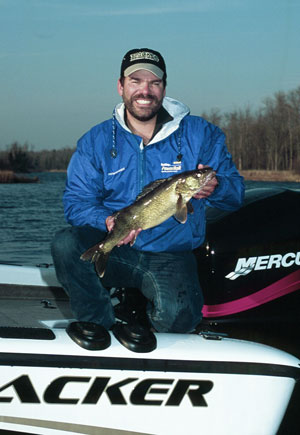|
Fishing “Hi-C”
Walleyes!
by
Gary Parsons and Keith Kavajecz
April showers bring May flowers … but
the showers often turn in to torrential
 downpours,
and combined with the run-off from melting snows, many of the rivers in
the “walleye belt” run high, muddy and fast this time of year … what
some of us like to call “Hi-C”, or “Heavy Current”. Not a walleye
angler’s favorite conditions at all. One might think the solution would
be a fairly simple one … look for areas of reduced current … but the
problem is, while that may be easier for the fishermen, its not
necessarily where the fish are. And it doesn’t just have to be a
rain-swollen river that runs Hi-C … there are plenty of rivers that run
fast on an ordinary day (the Detroit River is a great example), or areas
of an otherwise meandering flow that exhibit Hi-C characteristics due
things like wing dams, narrows or just because it happens to be a fast
stretch of river. downpours,
and combined with the run-off from melting snows, many of the rivers in
the “walleye belt” run high, muddy and fast this time of year … what
some of us like to call “Hi-C”, or “Heavy Current”. Not a walleye
angler’s favorite conditions at all. One might think the solution would
be a fairly simple one … look for areas of reduced current … but the
problem is, while that may be easier for the fishermen, its not
necessarily where the fish are. And it doesn’t just have to be a
rain-swollen river that runs Hi-C … there are plenty of rivers that run
fast on an ordinary day (the Detroit River is a great example), or areas
of an otherwise meandering flow that exhibit Hi-C characteristics due
things like wing dams, narrows or just because it happens to be a fast
stretch of river.
Walleyes seek out
these areas because, while the current may be ripping on the surface,
they are still able to find little nooks and crannies along the bottom
where they can sit out of the current, darting out to grab a quick meal
as the current sweeps it by. If the fish’s best chance for a meal is in
the heavy current, that’s where most of the fish will be.
Bottom line is …
the walleyes aren’t always where we’d like them to be … they’re not
always going to be in “easy to fish” areas of the river, accessible by
“conventional” river tactics like vertical jigging. Our goal here is to
share a few tried-and-true techniques for fishing walleyes in heavy
current, realizing that although this situation isn’t always the easiest
fishing in the world ... it’s often the best walleye fishing available.
The key to any
tactic that is successful in heavy current is that it gives the angler
control and keeps the bait near the bottom. That means the use of heavy
weights … the stronger the current you’re fishing, the heavier the
weight you’ll need to control the presentation. You also want a
presentation that allows you to “Cover and Hover” … that is to cover
water, either by moving upstream, slipping down stream and even sliding
cross-stream searching for these isolated spots that are holding the
walleyes.
The most popular
technique for fishing heavy current is what’s known as 3-way Rigging.
The rig starts with a 3-way swivel tied to a main line of 10 pound test
FireLine. The FireLine is nice because it maximizes feel and its small
diameter cuts the current better than monofilament. To the second leg of
the swivel tie a twelve inch piece of 6 pound test mono with a bell
sinker at the end. Weights will vary from about 1 to 3 ounces depending
on the amount of current and weight needed to keep bottom contact. Think
of this much the same as you would bottom bouncer fishing … you want to
keep the rig at about a 45 degree angle from the rod tip to the bottom …
this will give you the best feel and control.
At the business end
of the 3-way, run a 3 foot leader of 10 pound test mono (or another good
choice would be Vanish Fluorocarbon) to your bait of choice. There are
several good lure options for 3-ways ranging from small floating
crankbaits to streamer flies. One rig that has been very successful
over the years, is called a “D-Rig” or Dubuque Rig, popularized on the
Mississippi River. It consists of a #2 Aberdeen hook dressed with a
three inch twister tail style grub like a Berkley Power Grub or a GULP
Minnow Grub in high-visibility colors like chartreuse, white, orange or
yellow, and tipped with a small minnow or half a nightcrawler. We also
add a red bead just ahead of the hook for added color. The nice thing
here is that while swimming in the current, the Berkley tail is thumping
along creating vibration, with plenty of fish attracting color and is
dispersing a scent trail… so there’s a lot of attraction to entice the
fish.
While 3-ways will
handle most “Hi-C” fishing scenarios, there are situations that call for
even heavier approaches. Anglers on the Detroit River between
Lake St. Clair
and Lake Erie deal with extremely
heavy current … up to 5 to 7 mph
… virtually every day. That’s some serious current, and its one area
where Handlining has become very popular. Handlining resembles a
throw-back to more ancient angling methods, but is really a very
effective way to fish extreme current conditions. It does require some
specialized equipment … most importantly being the reel. What’s used is
an automatic retrieval reel spooled with a wire cable, to which is
attached a weight of a pound to a pound and a half. Between the weight
and the cable is what’s called the shank … a section of cable with up to
three leader connection points spread about a foot apart. The Riviera
company out of Michigan offers a complete Handlining kit which includes
the reel, cable, shank and other various hardware to get you started off
on the right foot.
The common set up
would be to run a leader of 5 to 10 feet of 20 pound test Vanish
Fluorocarbon from the lowest connector on the shank (about 12 inches up
from the weight) and then another leader twice the length of the first
one off the next connector on the shank. The lures most often used with
Handlining are Rapala Original Floating Minnows in sized #7 to #13 or
flutter spoons. The heavy leaders are an advantage for two reasons …
tangles do occasionally occur and the heavier line is easier to
untangle, and if you do snag the lure, you can usually pull the lure
free by straightening the hook out a bit.
The reel is mounted
on the side of the boat, the angler grabs the cable in his hand, and the
rig is worked in a jigging motion. When a fish is hooked, it’s much like
fishing a tip-up in the winter … the line is brought in by hand. Because
of the long leaders used, long-handled nets like Frabill’s Tru-Trax 3814
which extends to 96 inches are a huge help. Many Handliners also
suggest that using a leather glove on the line hand is a good idea.
A variation of the
Handline that many anglers now starting to use is a technique called
Rod-Lining. Here, the use of a short, heavy-action rod is used in place
of the bare hand. We use the Pete Maina Signature Series 6’6” medium
heavy Muskie Rod, with a reel spooled with 30 pound test FireLine. With
this rig, we’ll use weights from six to eight ounces, and rig this much
like the Handlining set-up, using two 3-way swivels above the weight to
run the leaders off of.
So when the
walleyes in your river aren’t in the “easy” water … look for them in the
“Hi-C” … the heavy current … and use one of these heavy metal tactics.
It may not be the easiest walleye fishing you’ll ever experience … but
then no one ever said that the best fishing was always going to be easy.
Editor's
Note:
If you
have questions or comments on this or other articles of ours you may
have read, contact us through our website at
www.thenextbite.com.
|





 downpours,
and combined with the run-off from melting snows, many of the rivers in
the “walleye belt” run high, muddy and fast this time of year … what
some of us like to call “Hi-C”, or “Heavy Current”. Not a walleye
angler’s favorite conditions at all. One might think the solution would
be a fairly simple one … look for areas of reduced current … but the
problem is, while that may be easier for the fishermen, its not
necessarily where the fish are. And it doesn’t just have to be a
rain-swollen river that runs Hi-C … there are plenty of rivers that run
fast on an ordinary day (the Detroit River is a great example), or areas
of an otherwise meandering flow that exhibit Hi-C characteristics due
things like wing dams, narrows or just because it happens to be a fast
stretch of river.
downpours,
and combined with the run-off from melting snows, many of the rivers in
the “walleye belt” run high, muddy and fast this time of year … what
some of us like to call “Hi-C”, or “Heavy Current”. Not a walleye
angler’s favorite conditions at all. One might think the solution would
be a fairly simple one … look for areas of reduced current … but the
problem is, while that may be easier for the fishermen, its not
necessarily where the fish are. And it doesn’t just have to be a
rain-swollen river that runs Hi-C … there are plenty of rivers that run
fast on an ordinary day (the Detroit River is a great example), or areas
of an otherwise meandering flow that exhibit Hi-C characteristics due
things like wing dams, narrows or just because it happens to be a fast
stretch of river.